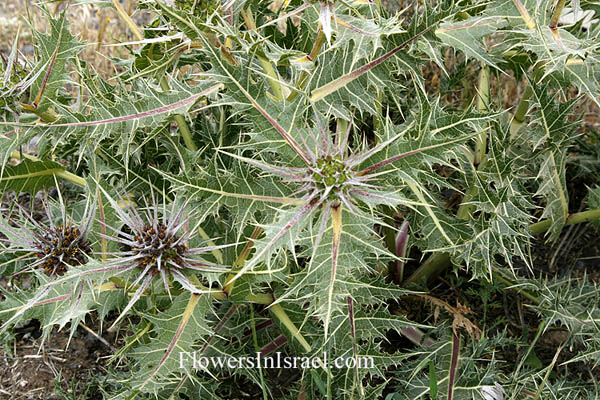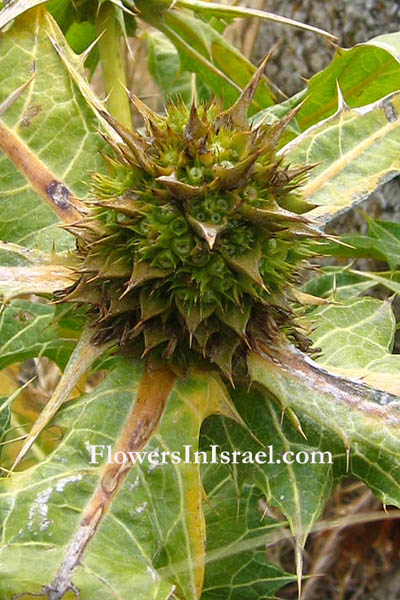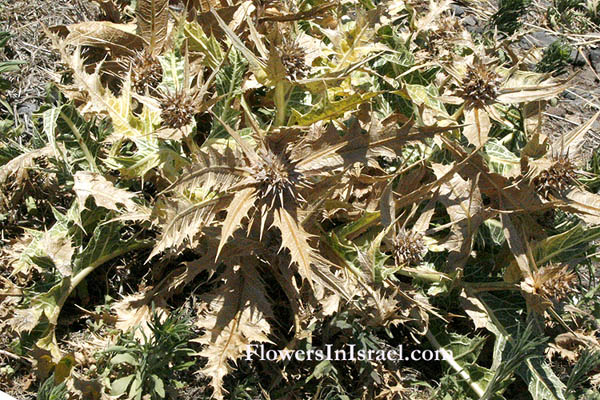Hebrew: עכובית הגלגל, Arabic: عكوب , كعوب
| Scientific name: | Gundelia tournefortii L. | |
| Common name: | Galgal, Tumbleweed, Tumble Thistle | |
| Hebrew name: | Akuvit ha-galgal, עכובית הגלגל | |
| Arabic name: | عكوب , كعوب | |
| Plant Family: | Compositae / Asteraceae, מורכבים |

|
| Life form: | Hemicryptophyte | |
| Spinescence: | Leaves, bracts | |
| Stems: | 20-40 cm in height, branching from the base, spiny plant | |
| Leaves: | Alternate, rosette, dissected, pinnate or bipinnate, dentate or serrate, spinescent | |
| Inflorescence: | Central stem bearing about a dozen inflorescence branches, ending with a compound spiny ovoid head 4-8 cm in diameter | |
| Flowers: | Hermaphrodite; purple, yellow, dense arachnoid hairs | |
| Fruits / pods: | Achenes; Upon maturation, the above-ground parts of the plant dry, and later in late-spring to early summer they become detached from the root, and disperse their fruits as they are rolled by the wind over large distances ( a tumbleweed) | |
| Flowering Period: | March, April, May | |
| Habitat: | Batha, Phrygana, Shrub-steppes | |
| Distribution: | Mediterranean Woodlands and Shrublands, Semi-steppe shrublands, Shrub-steppes, Montane vegetation of Mt. Hermon | |
| Chorotype: | Irano-Turanian | |
| Summer shedding: | Ephemeral |

Location: Bene Zion Nature Reserve Derivation of the botanical name: Gundelia, named for Andreas Gundelsheimer (1668–1715), a German botanist, who accompanied Tournefort in his journey into the Levant. tournefortii, named for Joseph Pitton de Tournefort (1656—1708), French botanist, who was professor of botany at the Jardin des Plantes in Paris.
It came under the spotlights in 1998, when its pollen grains were found on the Shroud of Turin. In modern Hebrew it is called "Akuvit ha-galgal." This name combines the Talmudic name for the plant (akkub), which survives in the modern Arabic name for the plant, with the Biblical Galgal. This species, native to semi-desert areas of Jerusalem and the Near East, is related to thistles and artichokes. Some Bible scholars think that the tumbleweed of Psalm 83: 14 ("Make them like tumbleweed, O my God, like galgal before the wind") is akoub. By the metaphor of galgal, the Psalmist is asking the Lord to make Israel's enemies like galgal: although they look frightening, their base is weak. The whole plant can be driven by the wind and it will be gone. The use of this plant is apparently quite old, being mentioned in the Babylonian Talmud and the Bible. This is the plant called silybum by Dioscorides. Gundelia tournefortii blooms in Israel from February (in the semi-desert warm parts) to May (in Jerusalem). Some gather these plants in the wild for culinary purposes. In March akoub plants are cut at the base and the prickles removed. The edible parts are the leaves, stems, roots, and undeveloped flower buds, the last mentioned being the most popular. The soft white part of the young leaves, the part between the root and the soil surface, is used by Bedouin and Arabs to make akkub soup. The most popular preparation for gundelia in the Palestinian Arab villages of northern Israel is in which the inflorescence, young stems and leaves are cut, fried in olive oil, then boiled with meat chops until well done, and then a boiled yogurt suspension is added and the mixture is left to boil for a few minutes before the meal is ready for serving. The plant tastes like a cross between asparagus and artichoke. By mid-May, the akoub stem has separated from the root, allowing the entire plant to be carried by the wind. The whole plant is round-so that it can roll like a ball. When the seeds of the dead fruit are ready to be dispersed, the base of the stem is disconnected from the thick root by means of an especially weak tissue which develops at just the right time. The plant then rolls, driven by the wind, dispersing its seeds on steppe and field. (Galgal also means wheel in Hebrew; the plant's name probably derived from its habit of rolling across the fields like a wheel). The sound of dry galgal plants rolling with the wind is a memorable experience to those who live amid these plants. Akoub's dispersal takes place at about the same time as wheat harvest as indicated by the prophet Isaiah (17: 13) Bible Resources:



|